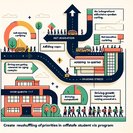
Australia’s Department of Home Affairs has switched on Ministerial Direction 115 (MD 115), a legally-binding instruction that instantly rewires how every offshore Student Visa (subclass 500) application is queued and decided. Effective 14 November 2025, the directive replaces last year’s “managed-growth” order and cements a three-tier, traffic-light system that sorts files by the compliance record and enrolment utilisation of each education provider.
In practice, Tier 1 providers—schools, English-language colleges, government-funded TAFEs, postgraduate-research institutions and DFAT-sponsored courses—now receive decisions in as little as one to four weeks. Tier 2 covers higher-education and VET institutions that are using less than 80 per cent of their 2026 planning allocation, with indicative processing of five to eight weeks. Tier 3, the new “slow lane”, captures providers that have overshot their allocation by 15 per cent or more; their applicants face waits of nine to twelve weeks. Once an application is snap-shotted into a tier it cannot be upgraded, creating powerful incentives for universities to stay within quota.
![Australia Activates Ministerial Direction 115, Re-Ranking All Offshore Student-Visa Applications]()
The shift comes against a backdrop of a 26 per cent drop in new offshore student-visa lodgements this year and public pressure to ease rental-market strains in major cities. Canberra argues that slower, better-targeted growth will push more students towards regional campuses that still enjoy Tier 1 priority. Education agents are already advising Indian, Chinese and Nepali students to check an institution’s tier before paying deposits, while corporates planning expatriate assignments for the January 2026 intake are being urged to build additional lead time into mobility schedules.
MD 115 also tightens on-shore flexibility. Several temporary visas (Visitor, Temporary Graduate, Maritime Crew) can no longer be converted to Student visas inside Australia, closing a popular last-minute workaround. Work-rights rules stay largely unchanged—48 hours a fortnight during term, unlimited in course breaks—but the directive reinforces documentation checks around English, financial capacity and genuine-student intent, especially for applicants packaging multiple courses.
For multinational companies, the implications go beyond the education sector. Longer queues for Student visas will flow into dependent visas, dual-career moves and housing budgets, particularly in Sydney and Melbourne where rental markets remain tight. Regional campuses such as La Trobe’s Bendigo site or James Cook University’s Townsville campus may now become attractive alternatives for employees’ families, potentially redistributing international-student spending to second-tier cities and helping companies control assignment costs.
In practice, Tier 1 providers—schools, English-language colleges, government-funded TAFEs, postgraduate-research institutions and DFAT-sponsored courses—now receive decisions in as little as one to four weeks. Tier 2 covers higher-education and VET institutions that are using less than 80 per cent of their 2026 planning allocation, with indicative processing of five to eight weeks. Tier 3, the new “slow lane”, captures providers that have overshot their allocation by 15 per cent or more; their applicants face waits of nine to twelve weeks. Once an application is snap-shotted into a tier it cannot be upgraded, creating powerful incentives for universities to stay within quota.

The shift comes against a backdrop of a 26 per cent drop in new offshore student-visa lodgements this year and public pressure to ease rental-market strains in major cities. Canberra argues that slower, better-targeted growth will push more students towards regional campuses that still enjoy Tier 1 priority. Education agents are already advising Indian, Chinese and Nepali students to check an institution’s tier before paying deposits, while corporates planning expatriate assignments for the January 2026 intake are being urged to build additional lead time into mobility schedules.
MD 115 also tightens on-shore flexibility. Several temporary visas (Visitor, Temporary Graduate, Maritime Crew) can no longer be converted to Student visas inside Australia, closing a popular last-minute workaround. Work-rights rules stay largely unchanged—48 hours a fortnight during term, unlimited in course breaks—but the directive reinforces documentation checks around English, financial capacity and genuine-student intent, especially for applicants packaging multiple courses.
For multinational companies, the implications go beyond the education sector. Longer queues for Student visas will flow into dependent visas, dual-career moves and housing budgets, particularly in Sydney and Melbourne where rental markets remain tight. Regional campuses such as La Trobe’s Bendigo site or James Cook University’s Townsville campus may now become attractive alternatives for employees’ families, potentially redistributing international-student spending to second-tier cities and helping companies control assignment costs.







